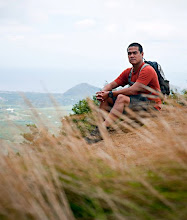Edited by Matthew Ing.
Rain. It happens a lot on our islands. It is the source of things to come: greener landscapes, cooler weather, and nourishment for the crops. The early Hawaiians, like any other civilization, welcomed the rains and used it to their advantage. From a drizzle or a heavy downpour, the rain is beneficial in every aspect of life. With rain comes beauty.
It’s March on Oahu, the
wettest month of the year. A large storm
approaching from the south blankets the island, causing a good amount of
flooding on the northeastern portion of the island from Kaneohe to Laie. In the small town of Ka’a’awa is a small valley known as
Makaua. At the back of the valley is a
waterfall that only flows during periods of heavy rains. Usually a dry waterfall chute at its lowest
tier, Makaua Falls stands about 200 feet, and for
those who have seen Makaua flowing would agree that is is one of the most
beautiful waterfalls on the island.
Unlike other arduous waterfall hikes, the trail to Makaua takes only
half an hour.
Arriving in Ka’a’awa at 9am, I meet with David
Chatsuthiphan, Lei Yamasaki, and Ryan Chang.
The rain fell hard on the way to our rendezvous point, but it had
stopped once we geared up and started the hike.
Even more depressing is the view from the road into the valley. We see that the upper tiers of the waterfall
are not flowing at all. Regardless, we
set off into the valley, hoping for a downpour.
At the streambed, we hear the sound of clashing thunder
directly above us. It’s a good sign, but
a flash flood in Makaua
Valley could prove
deadly. Along the way we plan out our
escape routes to higher ground where the valley walls narrow.
Further in the valley walls close in. We climb up several small waterfalls, and
finally hit the back of the valley. Just
as we thought, the waterfalls are a mere trickle.
Our disappointment worsens as the downpours only last a
couple minutes, then completely stop and do the same off-and-on tease for about
an hour. The hour passes, and we turn
around and decide to head back.
Several minutes downstream, the sun lit on the surrounding
landscape dims. The clouds grow thicker,
and the rain falls at a tremendous rate.
We turn back to look at the waterfall through the trees and as if
someone turned on a switch, Makaua
Falls is alive. With excitement we retrace our steps back to
the waterfall, looking up at the t5wo streams of water cascading into a small
pool. The rain stopped intermittently,
with just enough time for us to point our cameras up at the sky to capture
raindrop-free images of Makaua
Falls. The wait is all worthwhile.
There is something akin to patience and beauty. Like the rare waterfall that needs rain to
come alive, the kalo in the lo’i, the low tide for the fish ponds, and the
clear skies above to navigate the Pacific by boat all have something in common:
the wait. The wait is the source of
beauty. The kalo must be ripe for
consumption. The tide must be low to
snag the fish. The clouds must clear to
set sail. The rain must fall to enliven
the dry waterfall chute. Patience is a
virtue that yields to beauty: that source of beauty Hawaiians know all too
well.


